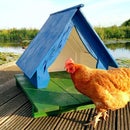Introduction: DIY Wheels for Bike or Trike or Trailer
I am building a DIY trike with two wheels at the front. These wheels will only be supported at one side as there will not be a fork, so I need wheels with a much stronger and thicker axle than regular bike wheels. I also want to use disc brakes, because it makes mounting the brake system on my trike easier and I think it looks better than rim brakes.
I searched the internet for 20" bike wheels with a thick axle and with the possibility to mount disk brakes, but I could not really find an affordable solution. I did find suitable hubs, but they were 250 euros each and then I would still need rims, and tires and spokes, so then it would cost in total more than 600 euros for two wheels.
I do like metalworking, and I saw some homemade wheels on the internet, so I decided to try to make my own wheels from old rims, rebar and pipe.
During the project I took less photos than I do when I plan to write an Instructable, because I did not plan on publishing anything. Now that I made the wheels, I am very happy with the result, so I decided to share how I made them. I think I still have enough photos to show you how I made the wheels, and I wrote down more details in the text.
Supplies
2x rims from 20" bike wheels.
6 mm rebar, approximately 8 lengths of 2 meters.
2x threaded rod M14, 200 mm each.
4x M14 nuts (locknuts).
4x new ball bearings (+ 2 old ones to be used during welding). Outer diameter 35 mm, inner diameter 15 mm.
2x 60 mm long aluminum tube, 20 mm outer diameter.
2x disc brake set
12x M5 bolt
12x M5 locknut
2x 80 mm pipe with 34 mm inner diameter.
2x tire set
To make this project you need a welding machine and an angle grinder. If you have a lathe, that is perfect. I do not have a lathe, but fortunately one of my friends has a lathe, so that solved the problem.
Step 1: Finding Rims and Cleaning Them
I removed the tires and the spokes from two old 20" bike wheels, which gave my 2 rusty rims to work with. I also have much better-looking rims, but I did not want to destroy good quality rims, so I decided to work with the worst looking rims that I had. Although they were rusty and old, they still had the right shape, so they were round and not bend or twisted, which is very important in order to get a good result. I checked if the rims were perfectly round by measuring the diameter in several directions and that size was every time the same.
I used a wire brush and some sandpaper to remove the rust and also most of the chrome from the rim. That was not really needed for welding, but I planned to paint the wheels when they were finished and now the rims were much easier to clean than later on when the rebar spokes are in place.
Step 2: Reinforcing the Rims With Rebar
Since rims for bike wheels are not very strong without all the regular spokes, I had to reinforce them, and I used 6 mm thick rebar for that. The rebar should be bent into a circle with a diameter that is approximately the same as the inner diameter of the rim. The easiest method is to use something round (for example a large planter) with approximately the same diameter as the rims and bend the rebar around that. It does not have to be exact, and it is no problem if the diameter of the circle is 5 centimeters (2") smaller or larger than the rim. I recommend keeping the rebar a bit longer than needed, as it is easier to trim the ends of when the rebar circle is almost complete.
As you can see on the last photo, I made the welds on one of the rims quite evenly spaced and on the other rim the distance between the welds is not the same. I made the irregular one first and then decided it would look nicer if the distance between the welds was the same. So, for the second rim I used a marker to mark points on the rim in the middle between the holes for the original spokes and I made the welds at these marks.
I used a MIG welding machine and first made a tack weld to attach the rebar to the rim. I pushed the rebar into the rim and used a piece of wood and a clamp to keep the rebar at the right height in the rim. Then I used pliers in one hand to pull the rebar against the rim and used my other hand to weld the rebar.
When I had almost completed the circle, I used a grinder to trim the excess ends of the rebar.
Each rim has two circles of rebar welded to it and they make the rim much stronger than before.
I checked if my rims were still perfectly round, and they were. Since I only made tack welds on the rims there was no welding distortion.
Step 3: Start Making Hubs: Welding Tabs for Disc Brakes
Now that I have rims, I also need hubs, before I can weld spokes between the rims and the hubs.
I selected the pipe that I used for my hubs based on the diameter of ball bearings that I could buy. The outer diameter of my ball bearings was 35 mm and the inner diameter of the pipe was 34 mm. I will ask a friend with a lathe to slightly increase the inner diameter of the pipe so there will be a good place to fit the bearings and a small ridge will remain in the pipe to prevent that the bearings can go in too deep.
I cut two pieces of pipe, each 80 mm long.
The rotors of my disc brakes have 6 holes for mounting bolts. I used the holes in the rotors as template and marked 6 points at the sides of the pipes. The wall thickness of my pipe was not enough to hold the screws for the rotors of the disc brakes, so I added material by welding 6 blobs of metal to one side of each pipe as you can see on the photos. The blobs did not look very nice, so I used an angle grinder to make the shape better.
The rotors of the disc brakes have to be mounted on a flat and straight surface of the hubs, so I decided to ask my friend to make a nice surface finish with his lathe too.
Step 4: Make Axles and Hubs
I had M14 threaded rods and ball bearings with a hole size of 15 mm. So somehow, I needed to increase the diameter of the threaded rod from 14 to 15 mm at the locations where the bearings would ride. I added some metal on the threaded rod with my welding machine and asked my friend to turn the threaded rods on his lathe to make the diameter 15 mm. After that the ball bearing fits nicely on my axle made from the threaded rod.
My friend also removed a little bit from the inside of the pipe and just deep enough so the ball bearing will fit flush in the pipe. The bearing cannot be pushed further into the pipe because there is now a ridge.
I cut two pieces of 60 mm long from an aluminum pipe. This pipe had an outer diameter of 20 mm and an inner diameter of 16 mm, so it fits over my M14 axle, and it only touches the inner ring of the bearing. This aluminum pipe will support the inner ring of the bearing, so it will not be pushed into the pipe when I tighten the nuts to keep the bearings in place. Make sure when you cut this aluminum pipe that the length exactly matches the distance between the ball bearings.
Step 5: Add Bolts for Disc Brakes
Using again the rotors of the disc brakes as template I marked where I had to drill holes. I drilled holes of 5 mm diameter in the tabs until the drill bit came out at the back side of the six tabs.
I cut the head off some M5 bolts, to make short threaded rods, placed them in the holes and welded them in place at the back side of the tabs. So, now I have threads that are fixed in place, and I can place the rotors and use locknuts to keep the rotors firmly attached to the hubs.
You can see the rotor in place on the photo at the next step.
Step 6: Mark the Positions for the Spokes
I measured the circumference of my hub and that could easily be divided by 9, so I decided to use 2x9= 18 spokes on each wheel. Originally there had been 28 regular spokes on the rims that I used, but I wanted to use less spokes since I am using 6mm rebar which is much stronger than the original 2 mm spokes.
I marked 9 equal sections on the piece of paper that fitted around my hub and transferred those points to the hub. I did that on both sides of the hubs but shifted the marks at the other side of the hub to alternate the position of the spokes.
To mark the positions on the rims, I used the cardboard template that I made for my egg project:
Large Egg Made From a Single 2x4 : 24 Steps (with Pictures) - Instructables
Since I wanted 9 sections and a circle is 360 degrees, each section should be 360/9= 40 degrees. I cut a piece of paper with an angle of 40 degrees and used that to mark 9 sections. Then I transferred the 9 marks to the rim, flipped the rim over and marked the other 9 sections in the middle between the first marks. That gave me 18 marks for spokes on the rim too.
Step 7: Cutting Spokes From Rebar
I measured how long the spokes should be and used an angle grinder to cut 9 spokes from rebar.
That was not the best method, because these spokes were slightly to long or slightly to short when I wanted to weld them in place. It is better to start by cutting just 2 spokes. One can be welded in place and the second one can be used to check the length for the next spoke. If the next spoke needs to be slightly longer or slighty shorter, you can immediately cut the next spoke to the right length.
Step 8: Tack Welding Spokes, But Keep Checking the Alignment
This is the most important step in making the wheel.
(Please be aware that I used old bearings for this step, as the bearings can get damaged from the heat and the current of the welding process. After welding, I removed the old bearings and replaced them with new bearings.)
My setup was as follows:
I have a vise on the workbench and the M14 axle is firmly clamped in the vise. The axle cannot move, but the hub can rotate around the axle.
I had the rotor of the disc brake bolted to the hub and I placed pieces of wood of equal thickness on the rotor to make a sort of support for the rims. The wood has to be of the right thickness to get the middle of the rim at the same height as the middle of the hub, so the wheels will be symmetrical.
I placed the red piece of steel next to the rim and clamped a piece of wood on it which pointed at the edge of the rim. Now I rotated the hub around and the rim also rotated because it was sitting on the wood on the rotor. It was now just a matter of checking if the distance between the rim and my wooden indicator changed when I rotated the hub. Then I kept adjusting the position of the rim and checking it by rotating the hub and watching the wooden indicator until the rim and hub were perfectly centered. I also checked that the marks for the spokes on the rim were in line with the marks on the hub so I could weld the spokes at those marks.
Then I covered the rotors with a rag to prevent welding spatter sticking to the rotors.
Next, I welded the first spoke between the marks and checked again if the rim was still perfectly centered. With just one spoke in place it can still easily be adjusted. The most important thing is to make sure that the hub stays in the center.
Now it is a matter of tack welding one spoke at a time and keep checking the alignment. The second spoke should be at the opposite side of the circle as the first one. The third and fourth should be placed to get the shape of a X so the rim is supported at 4 sides. Then tack weld the other 5 spokes between the first 4.
With 9 spokes tack welded in place, it is still possible to align the wheel a bit with the use of some force and a crowbar.
Step 9: Full Welding of All Spokes
After tack welding the first 9 spokes, I checked the alignment one more time and then I fully welded these 9 spokes. I used a vise to hold the wheel in a vertical position, so I had good access to the spokes for welding.
I covered the threads with some rags, so I would not get any welding spatter on the threads.
With just 9 spokes fully welded the wheel already felt very strong and the alignment was not affected anymore when I welded the spokes of the other side of the wheel.
After completely welding the wheel, I checked the alignment once more with my wooden indicator. There is a small misalignment of 1 mm in my DIY wheel, but that is also present in the wheels on my regular bike. So, I am very happy with how it turned out.
Step 10: Paint
After the wheels had cooled down from welding, I cleaned them and then I used a rattle can to paint the wheels black. I first used a layer of primer and after that a base coat.
Step 11: Put the Tires on the Wheels
I used rim tape from an old wheel on my rims as the holes from the original spokes are still present. You can see the bright yellow of the rim tape through the holes for the original spokes.
After that I put the tires on the wheels and inflated them. Since I have a wheel for the right-hand side and a wheel for the left-hand side, the tires will rotate in opposite directions. I paid attention to the arrow on the tire which showed the correct direction for rotation.
Step 12: Mount the Rotors
Be aware that both the tires and the rotors have an arrow indicating the direction of the rotation. The arrows are only mentioned on one side of the rotor, so to show both arrows on the photo, I had to hold the rotor with this side up, but that is not the right direction for installation. So, after taking the photo, I flipped the rotor over and installed it, so the arrows point in the right direction.
I used lock nuts for the installation of the rotor, so the nuts will not come off by vibration.
Step 13: Finished
The wheels are ready, and I am happy with the result.

Runner Up in the
Metal Contest













